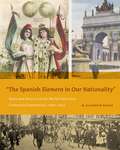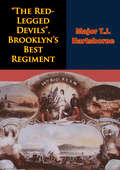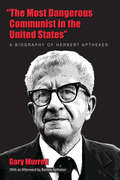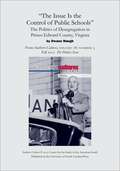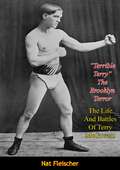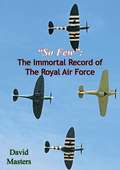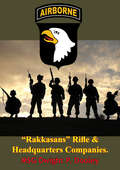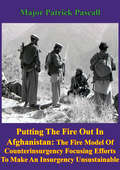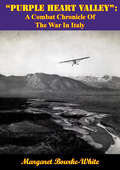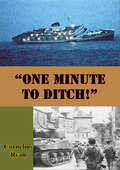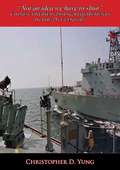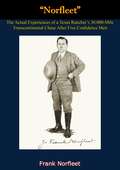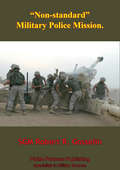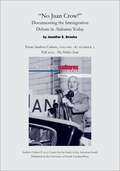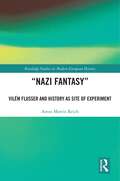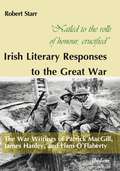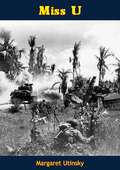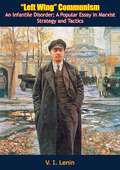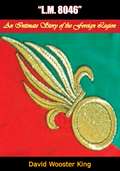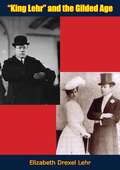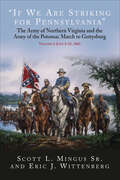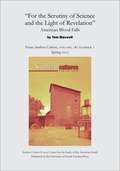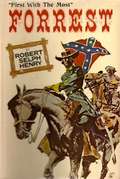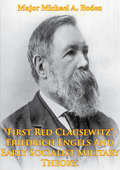- Table View
- List View
“The Spanish Element in Our Nationality”: Spain and America at the World’s Fairs and Centennial Celebrations, 1876–1915
by M. Elizabeth Boone"The Spanish Element in Our Nationality" delves beneath the traditional "English-only" narrative of U.S. history, using Spain’s participation in a series of international exhibitions to illuminate more fully the close and contested relationship between these two countries.Written histories invariably record the Spanish financing of Columbus’s historic voyage of 1492, but few consider Spain’s continuing influence on the development of U.S. national identity. In this book, M. Elizabeth Boone investigates the reasons for this problematic memory gap by chronicling a series of Spanish displays at international fairs. Studying the exhibition of paintings, the construction of ephemeral architectural space, and other manifestations of visual culture, Boone examines how Spain sought to position itself as a contributor to U.S. national identity, and how the United States—in comparison to other nations in North and South America—subverted and ignored Spain’s messages, making it possible to marginalize and ultimately obscure Spain’s relevance to the history of the United States.Bringing attention to the rich and understudied history of Spanish artistic production in the United States, "The Spanish Element in Our Nationality" recovers the "Spanishness" of U.S. national identity and explores the means by which Americans from Santiago to San Diego used exhibitions of Spanish art and history to mold their own modern self-image.
“The Red-Legged Devils”, Brooklyn’s Best Regiment
by Major T.J. HartshorneThe Fourteenth Regiment New York State Militia of Brooklyn, New York gathered an impressive combat record during the Civil War, yet the Professional Military Education world rarely takes notice of their deeds. They were first formed on 5 July 1847 when the New York State Legislature consolidated the individual militia companies into regiments. During the Civil War the Fourteenth Regiment fought in 29 engagements and sustained over 700 casualties. Their battles include participation in both Bull Runs, Antietam, Fredericksburg, Chancellorsville, Gettysburg, Wilderness and Spotsylvania. Though noted primarily for actions in the Civil War, the Regiment also served in the Spanish American War, World Wars I and II, and Korea, though under different unit designations. The Fourteenth Regiment's past can be a road to our future. An insight to their performance under fire can provide today's students a timeless template on how to conduct combat operations.
“The Most Dangerous Communist in the United States”: A Biography of Herbert Aptheker
by Bettina Aptheker Gary MurrellWhen J. Edgar Hoover declared Herbert Aptheker “the most dangerous Communist in the United States,” the notorious FBI director misconstrued his true significance. In this first book-length biography of Aptheker (1915–2003), Gary Murrell provides a balanced yet unflinching assessment of the controversial figure who was at once a leading historian of African America, radical political activist, literary executor of W. E. B. Du Bois, and lifelong member of the American Communist Party. Although blacklisted at U.S. universities, Aptheker published dozens of books, including the groundbreaking American Negro Slave Revolts (1943) and the monumental seven-volume Documentary History of the Negro People (1951–1994). He also edited four volumes of the correspondence and unpublished writings of Du Bois, an achievement that Eric Foner, writing in the New York Times Book Review, called “a milestone in the coming of age of Afro-American history.” As Murrell shows, Aptheker the historian was inseparable from Aptheker the leading Communist Party intellectual, polemicist, and agitator. During the 1960s, his ability to rouse and inspire both black and white student radicals made him one of the few Old Leftists accepted by the New Left. Aptheker had joined the CPUSA during its heyday in the 1930s, convinced that only through the party’s leadership could fascism be defeated and true liberation be achieved: he ended his affiliation five decades later in 1991 after the collapse of socialism in the Soviet Union and Eastern Europe. In an afterword, Bettina Aptheker adds to Murrell’s narrative by illuminating her mother Fay’s vital contributions to her father’s work and by affirming the particularly devastating challenges of life in a family dedicated to radical political and social change.
“The Issue Is the Control of Public Schools”: The Politics of Desegregation in Prince Edward County, Virginia
by Dwana WaughWarren Brown recounts his hurried educational career. Unable to attend school until he was ten years old, Brown completed twelve grades in just seven years."This article appears in the Fall 2012 issue of Southern Cultures. The full issue is also available as an ebook.Southern Cultures is published quarterly (spring, summer, fall, winter) by the University of North Carolina Press. The journal is sponsored by the University of North Carolina at Chapel Hill's Center for the Study of the American South.
“Terrible Terry” The Brooklyn Terror: The Life And Battles Of Terry McGovern
by Nat FleischerVeteran and expert boxing writer Nat Fleischer recounts the career of Terrible Terry McGovern, who dominated the Bantam and Featherweight classes at the turn of the 20th Century. Still regarded as one of the most destructive and effective Bantamweights of all time, a stocky, fast body puncher who won 45 of his fights via knock-out in an age of iron men.Historian Barry Deskins wrote, “Short blows to the body followed by a viscous straight right is McGovern’s strongest asset, particularly his work to the body.” Old time fight announcer Joe Humphreys said, Sept 1936 Ring Magazine, “McGovern was a lightning fast feinter and a terrible hitter. He was a great body puncher, an art that seems to be lost to the present generation.”“Unconquered and unconquerable Terry McGovern, the Brooklyn whirlwind fighter, stands today without a peer in the pugilistic world”-National Police Gazette after McGovern’s win over Erne.
“So Few”: The Immortal Record of The Royal Air Force
by David MastersOriginally published in 1941, this book is author David Masters' historical account of the Royal Air Force's feats and accomplishments during the Second World War: "I count it a privilege to write with firsthand knowledge of these flying crusaders who are fighting a holy war to preserve Christendom and the lives and liberties of earth-bound mortals. They are the flower of Great Britain and the British Empire, selected in the most scientific manner for the posts of honour which they have covered with so much glory. None but the best will do, and those who achieve their desire of becoming pilots and navigators and gunners and wireless operators in the Royal Air Force are in fact the finest specimens of young manhood who walk the earth, young men whose physical fitness, nervous control, mental alertness and swift muscular reactions make them fit to command and man the giant bombers and handle the darting fighters; they are the knights of the air whose prowess and sacrifice will conjure a new and nobler order out of the ruins created by Hitler and Mussolini. No trouble has been spared to ensure the accuracy of these pages which reflect the glory of the Royal Air Force. It may be taken that they are as authentic as any pages of official history."
“Rakkasans” Rifle & Headquarters Companies (Eyewitness To Modern War #3)
by MSG Dwight P. DooleySenior NCO MSG Dwight P. Dooley recounts his experiences of the War in Iraq when stationed there as part of the 101st "Screaming Eagles Airborne Division between 09/20/2005 - 05/18/2006.This paper explains the different experiences and the similarities I experienced as First Sergeant in Crusher & Hatchet Company, 1-187TH Infantry Regiment. Both companies presented completely different experiences but they were equally satisfying. My rifle company was a company known for its rough around the edges attitude and for its ability to eliminate any opposing threat. My headquarters company was known for its ability to figure things out and apply a logical and methodical approach to everything. These two companies were completely different in nature, but equal in their abilities to accomplish any given task.
“Putting Out The Fire In Afghanistan”: - The Fire Model of Counterinsurgency: Focusing Efforts to Make an Insurgency Unsustainable
by Major Patrick PascallThis monograph develops an alternative approach to counterinsurgency, and explains how the current narratives in the field of counterinsurgency are not completely accurate. Counterinsurgents only need to properly understand the environment and then concentrate their efforts in that critical area of the insurgency identified as the sustainer of that insurgency. The U.S. counterinsurgency (COIN) plan does not need to address all those lines of effort not directly related to the root cause of an insurgency, as those efforts may actually fuel the insurgency due to building unrealistic expectations among the populace.This monograph also develops the analogy that the four elements necessary for a fire (fuel, oxygen, heat, chain reaction) parallel the necessary elements of an insurgency (the fuel representing unresponsive government, oxygen representing existing structures/vulnerability, heat representing political/diplomatic factors, chain reaction representing the information environment, and the population). Like a fire, if one has a proper understanding of the environment, and can clearly identify the true sustainer of the insurgency (the root problem), then one only need to remove that one element from the equation, and that insurgency will be unsustainable.Having a simple approach will not only allow the counterinsurgents to better utilize their resources-in an Economy of Force-and allow them to Mass their power on one clear Objective, it will also remind counterinsurgents of the other Principle of War that has proven to be so critical in complex environments-simplicity.
“Purple Heart Valley”: A Combat Chronicle Of The War In Italy
by Margaret Bourke-WhiteAn excellent, richly illustrated, account of the bloodiest phase of the Italian campaign.Here is a report--in pictures and in words--of exactly what happened to our men during the bitterest phases of the Italian campaign. This report is not based upon a hurried visit behind the lines; Margaret Bourke-White spent a full five months on the Italian front photographing, questioning, observing, and living in close association with our troops. She was not content to remain safely behind the combat area. She flew over the German lines and narrowly escaped being shot down. On the ground she came closer to the enemy lines than any woman has been before the most advanced American post around Cassino.
“One Minute to Ditch!”
by Cornelius RyanPrize-winning True Stories of the Supreme Moment--When Men Suddenly Face DeathSome of these true stories are already famous because they have been dramatized on television. All of them take you straight to the heart of great moments of crisis.You'll know what it's like to look down at the wide Pacific and realize that your plane is going to ditch there.You'll twist the wheel of your racing car as it takes a narrow turn at Indianapolis.You'll struggle in cabin 56 of the S.S. Andrèa Doria during its five last frantic hours.In these and other stories, Cornelius Ryan, ace journalist, has caught the essence of that split-second that may be a man's last. Two of these pieces have won Benjamin Franklin Magazine awards."One Minute To Ditch!"--Thirty-one men, women and children high over the mid-Pacific in a failing plane. (Dramatized on TV.)Five Desperate Hours in Cabin 56--A story of the sinking of the S.S. Andrèa Doria told in gripping minute-by-minute detail. (Dramatized on TV.)The Major of St. Lô--A classic of the Normandy invasion, an unforgettable true story of quiet heroism. (Dramatized on TV.)These and other factual accounts are moving documents of crisis: of courage against the sudden fact of very possible death.
“Not an idea we have to shun”: Chinese overseas basing requirements in the 21st century
by Christopher D. YungChina's expanding international economic interests are likely to generate increasing demands for its navy, the People's Liberation Army Navy (PLAN), to operate out of area to protect Chinese citizens, investments, and sea lines of communication. The frequency, intensity, type, and location of such operations will determine the associated logistics support requirements, with distance from China, size and duration, and combat intensity being especially important drivers. How will the PLAN employ overseas bases and facilities to support these expanding operational requirements? The assessment in this book is based on Chinese writings, comments by Chinese military officers and analysts, observations of PLAN operational patterns, analysis of the overseas military logistics models other countries have employed, and interviews with military logisticians. China's rapidly expanding international interests are likely to produce a parallel expansion of PLAN operations, which would make the current PLAN tactic, exclusive reliance on commercial port access, untenable due to cost and capacity factors. This would certainly be true if China contemplated engaging in higher intensity combat operations. This book considers six logistics models that might support expanded PLAN overseas operations: the Pit Stop Model, Lean Colonial Model, Dual Use Logistics Facility, String of Pearls Model, Warehouse Model, and Model USA. Each model is analyzed in terms of its ability to support likely future naval missions to advance China's expanding overseas economic, political, and security interests and in light of longstanding Chinese foreign policy principles.
“Norfleet”: The Actual Experiences of a Texas Rancher’s 30,000-Mile Transcontinental Chase After Five Confidence Men
by J. Frank Norfleet W. Franklin WhiteOriginally published in 1924, this is the true story of J. Frank Norfleet, a typical West Texas ranchman, and his four-year chase after a gang of international swindlers, which takes the reader on a transcontinental journey—from the Atlantic to the Pacific; from Mexico and Cuba into Canada.A gripping and incredible chronicle of one man’s dedication to break up an international crime ring.True story of West Texas rancher J. Frank Norfleet, cousin to General Robert E. Lee on his grandmother’s side, who was deceived and robbed by sophisticated politicians and financiers and proceeded to track them across continents—from the Atlantic to the Pacific; from Mexico and Cuba into Canada—to bring them to justice.Applauded by the U.S. Department of Justice, Norfleet set an example in his time that rings as true today—do not let yourself be abused by financial manipulators who pervert laws to rob the common man!A gripping and incredible chronicle of one man’s dedication to break up an international crime ring.
“Non-Standard” Military Police Mission (Eyewitness To Modern War #2)
by SGM Robert R. GosselinMy field artillery unit was mobilized to perform a non-standard military police mission during Operation Iraqi Freedom II. The unit was part of the largest National Guard mobilization from our state since the Vietnam era. The challenges of deploying a field artillery unit as an ad hoc MP company were many. The challenges were overcome through the strength of our NCO Corps. As I write this paper, I am preparing for a deployment, a non-standard mission with my current unit. As I compare the two mobilizations, it is apparent that the process for mobilizing, training and preparing our soldiers has improved since the first rotation, but issues concerning the selection of units for non-standard mission still exist five years later.
“No Juan Crow!”: Documenting the Immigration Debate in Alabama Today
by Jennifer E. BrooksThe bill gained quick notoriety for outdoing Arizona, Georgia, and all other states in the restrictions and penalties levied on unauthorized immigrants, as well as on the citizens, community members, employers, and health and law enforcement agencies that assist, employ, or regulate them."This article appears in the Fall 2012 issue of Southern Cultures. The full issue is also available as an ebook.Southern Cultures is published quarterly (spring, summer, fall, winter) by the University of North Carolina Press. The journal is sponsored by the University of North Carolina at Chapel Hill's Center for the Study of the American South.
“Nevada”: A Romance of the West
by Zane GreyTHE BLAZING BESTSELLER BY THE GREATEST NAME IN WESTERN FICTIONFrom the deep wild gorges of the sinister Mogollons in the north, down to the shimmering wastes of the Painted Desert, the rustlers murdered and robbed—while Arizona seethed dangerously. There was only one man who had the guts, the guns and the driving, urgent reason to buck that crew—and his name was Jim Lacy. Wanted by both sides of the law, Jim Lacy, alias Texas Jack, alias Nevada, wanted only one thing—”Dead or alive, clear my name.” “NEVADA” by Zane GreyCLEAR MY NAME!
“Nazi Fantasy”: Vilém Flusser and History as Site of Experiment (Routledge Studies in Modern European History)
by Amos Morris-ReichThis book brings together Vilém Flusser and intellectual Jewish history of the second half of the twentieth century. Flusser is viewed today by many scholars as the most original theoretician of media and photography in the second half of the twentieth century, and yet this is the first monograph about him in English.Combining elements of Flusser’s biography with a rigorous study of his writing, this book shows that concepts of ‘virtuality’, ‘medium’, and ‘embodiment’ underpin not only Flusser’s understanding of technological media, such as photography, but also his understanding of evolution and of real or imaginary biological organisms. This book argues that Flusser contended with Nazism in his writings on these biological and ecological themes. Two threads – and their relationship - are explored: the first bears on Nazism as undergirded by a biological perspective – an attempt to eradicate a population taken to be parasitic; in the second, Nazism is simply viewed as ‘stupid’. Such a line of inquiry necessarily leads to and includes our dealing with the ‘Nazi fantasy’, because fantasy was fused into Nazism’s own vision.This book will not only be an ideal resource for students and scholars of intellectual Jewish history but will interest anyone seeking an introduction to Flusser and the philosophy of science within the context of Nazism.
“Nailed to the rolls of honour, crucified”: The War Writings of Patrick MacGill, James Hanley, and Liam O’Flaherty
by Robert StarrThis book explores the war writings of Patrick MacGill, James Hanley, and Liam O’Flaherty, working class, Roman Catholic Irishmen, all of whom fought in the First World War as privates and who, collectively, it is argued, constitute a distinct trio of war writers. Through discussions focusing upon class, camaraderie, violence, religion, trauma, and the body, this book considers these Irish soldiers within a cultural, social, and historical context. Central to this examination is the idea that the motives for enlistment and the experience of army labor and even combat was such that military service was perceived as work rather than a duty or vocation undertaken in support of any prevailing doctrines of patriotism or sacrifice. The men’s Catholicism also shaped their aesthetic and philosophical responses to the war, even while the war conversely troubled their faith or confirmed their religious skepticism. The war writing of these men is located within both an Irish and a pan-European literary working class tradition, thereby permitting the texts to be viewed within a wider context than literature of the First World War, and from a perspective that goes beyond Ireland and Britain. These characteristics shape a perspective on the conflict very different from that of the canonical officer-writers, men such as Siegfried Sassoon, Robert Graves, or Edmund Blunden, whose work is considered alongside those of the three Irish soldier-writers.
“Miss U”
by Margaret UtinskyThis is the story of the heroism of Margaret Utinsky, who, against unbelievable and fantastic odds, for three years led an underground organization in the Philippines in a relentless and telling effort to aid American prisoners of war held by the Japanese. Dauntless and determined, she pushed into the background her own personal loss, faced the twin demons of physical and mental anguish, and “stood up” to circumstances and conditions which most of us find inconceivable. In her own words, she became “accustomed to doing the impossible.” And gaunt prisoners behind walls and wires, guerrillas in the hills, the faithful in Manila—all felt the force of the courageous leadership of this small dynamo, for whom “something always happened.”
“Left Wing” Communism: An Infantile Disorder; A Popular Essay in Marxist Strategy and Tactics
by V. I. Lenin"Left-Wing" Communism: An Infantile Disorder is a work by Vladimir Lenin attacking assorted critics of the Bolsheviks who claimed positions to their left. Most of these critics were proponents of ideologies later described as left communism.The book was written in 1920 and published in Russian, German, English and French later in the year. A copy was then distributed to each delegate at the 2nd World Congress of the Comintern, several of whom were mentioned by Lenin in the work.The present volume is a New Translation that was first published in the U.S. in 1940 and the UK in 1942. As with the earlier editions, the book is divided into ten chapters and contains an appendix, including a letter from David Wijnkoop on behalf of the Communist Party of Holland.
“L.M. 8046”: An Intimate Story of the Foreign Legion
by David Wooster KingStill a student at Harvard when World War I broke out, American David Wooster King joined the 135th Regiment of the French Foreign Legion in November 1914 and fought in the 1915 Champagne offensive and at Verdun and the Somme in 1916. He transferred to the American Army near the end of the war and served in the counterespionage section at Chaumont.“This book of David King’s is not a sermon. It does not preach and it carries no moral. It says in fact: ‘Here, my good friends who made me into a beautiful hero, is what happened to me while I was gaining that title. Take it or leave it and be damned to you or have a drink with me or do whatever you please, but for Heaven’s sake don’t kiss me for I am splashed with the blood of my dead comrades and I am dirty with the grime of a million miles of road.’”—Hendrik Van LoonA colourful and engrossing account, especially for 1915-1916.
“King Lehr” and the Gilded Age
by Elizabeth Drexel LehrHARRY SYMES LEHR was born in 1869 into a family that was neither wealthy nor socially prominent. His natural gift for entertaining and his penchant for hobnobbing with the very rich earned him entry to the powerful circle of the New York and Newport social elite, where Harry clowned his way to a position of prominence. One of his admirers and patrons, Mrs. Stuyvesant Fish, introduced him to a young widow, Elizabeth Wharton Drexel. Elizabeth was smitten with young Harry, his elegant dress, and outrageous behavior. They were soon married.But King Lehr had a secret—he was not what he seemed. On their wedding night he cruelly dictated the rules of their strange relationship to his new bride. For twenty-three years, Mrs. Lehr protected his secret and remained in a loveless and abusive marriage.After Harry’s death Elizabeth remarried, to the Baron Decies. Lady Decies wrote down her secret story in 1938, incorporating Harry’s most intimate diaries, and told all in this scandalous tale of power, desire, and deception.
“If We Are Striking for Pennsylvania”, Volume 1: The Army of Northern Virginia and the Army of the Potomac March to Gettysburg
by Eric J. Wittenberg Scott L. Mingus Sr.Scott L. Mingus Sr. and Eric J. Wittenberg, the authors of more than forty Civil War books, have once again teamed up to present a history of the opening moves of the Gettysburg Campaign in the two-volume study “If We Are Striking for Pennsylvania”: The Army of Northern Virginia and the Army of the Potomac March to Gettysburg. This compelling study is one of the first to integrate the military, media, political, social, economic, and civilian perspectives with rank-and-file accounts from the soldiers of both armies as they inexorably march toward their destiny at Gettysburg. This first installment covers June 3–21, 1863, while the second, spanning June 22–30, completes the march and carries the armies to the eve of the fighting. Gen. Robert E. Lee began moving part of his Army of Northern Virginia from the Old Dominion toward Pennsylvania on June 3, 1863. Lee believed his army needed to win a major victory on Northern soil if the South was to have a chance at winning the war. Transferring the fighting out of war-torn Virginia would allow the state time to heal while he supplied his army from untapped farms and stores in Maryland and the Keystone State. Lee had also convinced Pres. Jefferson Davis that his offensive would interfere with the Union effort to take Vicksburg in Mississippi. The bold movement would trigger extensive cavalry fighting and a major battle at Winchester before culminating in the bloody three-day battle at Gettysburg. As the Virginia army moved north, the Army of the Potomac responded by protecting the vital roads to Washington, D.C., in case Lee turned to threaten the capital. Opposing presidents Abraham Lincoln and Jefferson Davis, meanwhile, kept a close watch on the latest and often conflicting military intelligence gathered in the field. Throughout northern Virginia, central Maryland, and south-central Pennsylvania, meanwhile, civilians and soldiers alike struggled with the reality of a mobile campaign and the massive logistical needs of the armies. Thousands left written accounts of the passage of the long martial columns. Mingus and Wittenberg mined hundreds of primary accounts, newspapers, and other sources to produce this powerful and gripping account. As readers will quickly learn, much of it is glossed over in other studies of the campaign, which cannot be fully understood without a firm appreciation of what the armies (and civilians) did on their way to the small crossroads town in Pennsylvania.
“For the Scrutiny of Science and the Light of Revelation”: American Blood Falls
by Tom MaxwellShowers of blood, however dreadful, were not news. Pliny, Cicero, Livy, and Plutarch mentioned rains of blood and flesh. Zeus makes it rain blood, 'as a portent of slaughter,' in Homer's Iliad."This article appears in the Spring 2012 issue of Southern Cultures. The full issue is also available as an ebook.Southern Cultures is published quarterly (spring, summer, fall, winter) by the University of North Carolina Press. The journal is sponsored by the University of North Carolina at Chapel Hill's Center for the Study of the American South.
“First With The Most” Forrest
by Robert Selph HenryNathan Bedford Forrest did not invent mobilized guerilla warfare, but he did modernize and polish it to an extent that has left few theoretical areas for improvement. Tanks and jeeps, it could even be said, do not possess the mobility relative to the main force which they attach that Forrest's dedicated band of horsemen enjoyed. Following in the footsteps of Francis Marion and Lighthorse Harry Lee, American practitioners of the devastating hit-and-run cavalry attach of the Revolutionary War, Forrest raised their effective but geographically limited campaigns to an art-form spread over the widest possible tactical theatre. He accomplished this with superior knowledge of terrain and of horses coupled and with an iron will, a complete disregard for physical exhaustion (his own and that of his men) and, this book will demonstrate, by the most admirable sort of sheer country orneriness.Forrest, a man of simple upbringing, is the perfect symbol for the odd mélange that was the Confederate Army; patrician West Pointers like Lee side by side by unregenerate racists like Forrest. These well-bred students of battles and from the classical era were not prevented by an almost unimaginable difference in class from being able to recognize the tactical genius of a farmer from the low country...That any scholar of this history of warfare would have to judge Forrest rather more harshly for his conduct after the war than this conduct during it is just another tragic aspect of the larger tragedy that generated The War Between the States. Heroes rose from unlikely places and returned, when the time for heroism had past, to their more unheroic pursuits. Whether than return negates the valor shown during the conflict is only for you to determine, after you have learned of Forrest's life in all its aspects, heroic, and less so.
“First Red Clausewitz”: Friedrich Engels And Early Socialist Military Theory
by Major Michael A. BodenBetween the European revolutions of the mid-nineteenth century and the Franco-Prussian War in 1870, Friedrich Engels functioned as a writer, analyst, and critic concerning military affairs. His most essential commentaries were published, disseminated, and internalized by supporters of the proletarian revolution. This project concentrates on the tactical, operational, and technical aspects of Engels' military thought and the development of his concepts from his earliest writings until the Franco-Prussian War. Historians and commentators routinely ignore these aspects of military theory in examinations of Engels' work. This project will demonstrate that Engels possessed are markable level of military knowledge and a degree of insight at the operational and tactical levels of warfare and that that he should be considered not only as an important social and economic thinker, but also among the most significant contributors to the field of nineteenth-and twentieth-century military history and theory. Engels' most significant contributions exist in the manner by which he, as a key member of the socialist leadership in the nineteenth century, integrated the concept of armed insurgency into the conduct of a proletarian revolution. By drawing on the experiences of the French Revolution and the wars of Napoleon, and then the impact of mass-industrialization, Engels was the first person to specifically incorporate a force dynamic into the trajectory of a socialist revolution. Despite the fact that he was a civilian with no formal military training beyond service as a Prussian artilleryman in 1842, his contributions to the field of revolutionary military theory earn him distinction as one of the most important socialist writers of the nineteenth century.
